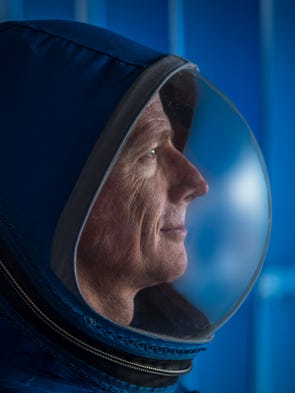
The spacesuit designed for astronauts riding Boeing’s Starliner space taxi makes a fashion statement for the 21st century, from its touchscreen-sensitive gloves to its color-coordinated shoes.
And all of it in Boeing blue.
The spacesuit made its public debut today during a media extravaganza at NASA’s Kennedy Space Center in Florida, with former NASA astronaut Chris Ferguson as one of the emcees.
“I was essentially the model for this as they built the suit around me,” said Ferguson, who commanded the final space shuttle mission in 2011 and now serves as Boeing’s director of crew and mission systems.
The CST-100 Starliner is being developed as a transport vehicle for NASA crews heading to and from the International Space Station. There’s a chance that Ferguson could take a ride as a Boeing test pilot, but for now, the composition of the initial crews is up in the air.
NASA has tapped four current astronauts – Eric Boe, Bob Behnken, Doug Hurley and Suni Williams – to train for the first round of commercial flights on the Starliner as well as on SpaceX’s Crew Dragon.
All four of those astronauts have been involved in testing the Starliner suit, which is designed for use inside the spacecraft during launch and entry.
“The most important part is that the suit will keep you alive,” Boe said in a NASA report on the unveiling. “It is a lot lighter, more form-fitting and it’s simpler, which is always a good thing. Complicated systems have more ways they can break, so simple is better on something like this.”
At less than 20 pounds, the suit weighs about 10 pounds less than the traditional orange launch-and-entry suit used during the shuttle era. The material lets water vapor pass through to keep astronauts from getting drenched in sweat, while retaining the air inside the suit.

The launch-and-entry suit can’t be used during spacewalks. Extravehicular activity requires a much bulkier suit that weighs about 280 pounds. “This is really something used internally, in the spacecraft only,” Ferguson explained.
The suit, designed by David Clark Company for Boeing, is meant to be pressurized in the event of an in-flight emergency.
“The spacesuit acts as the emergency backup to the spacecraft’s redundant life support systems,” said Richard Watson, subsystem manager for spacesuits for NASA’s Commercial Crew Program. “If everything goes perfectly on a mission, then you don’t need a spacesuit. It’s like having a fire extinguisher close by in the cockpit. You need it to be effective if it is needed.”
A lightweight helmet and visor are incorporated into the suit, and hang back like a hood when not in use. When the helmet’s needed, the wearer pulls it down over his or her face and simply zips it up.
The suit comes with twist-on, twist-off gloves, with fingertips that are touchscreen-sensitive so that astronauts can operate the Starliner’s streamlined displays. The integrated shoes look like cross-trainers, and come in a stylish color scheme that fades from deep blue to white.
Boeing and NASA will continue putting the adjustable blue suits to the test over the months of training to come. The current schedule calls for the first Starliner test flight to the space station to take place during the summer of 2018.







